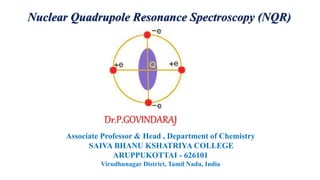
NQR Spectroscopy: Interaction of Nuclear Quadrupole Moment
- 1. Dr.P.GOVINDARAJ Associate Professor & Head , Department of Chemistry SAIVA BHANU KSHATRIYA COLLEGE ARUPPUKOTTAI - 626101 Virudhunagar District, Tamil Nadu, India Nuclear Quadrupole Resonance Spectroscopy (NQR)
- 2. Nuclear Quadrupole Resonance Spectroscopy (NQR) • NQR spectroscopy is a chemical analysis technique like NMR, in which the transitions of nuclear energy levels can be detected in the absence of a magnetic field by the absorption of radio frequency radiation. • The nuclear energy levels are formed due to the interaction between nuclear quadrupole moment and electric field gradient • NQR is applicable only to solids and not for liquids and gases, because the quadrupole moment average was found to zero Definition
- 3. Nuclear Quadrupole Resonance Spectroscopy (NQR) • A nucleus with I > ½ lack the spherical system along the spin axis resulted elongated (prolate spheroid) shape and compressed (oblate spheroid) shape along the spin axis Nuclear quadrupole moment and electric field gradient
- 4. Nuclear Quadrupole Resonance Spectroscopy (NQR) • The distorted shape generate electric (or nuclear) quadrupole moment (e Q) and it is defined by e Q = 𝑥,𝑦,𝑧 𝑟2(3 cos 2( − 1))d --------------(1) where 𝑥,𝑦,𝑧 is the charge density at (x,y,z) r is the distance of the volume element d from the nucleus is the angle which the radius vector r makes with the nuclear spin axis
- 5. Nuclear Quadrupole Resonance Spectroscopy (NQR) • The nuclear quadrupole moment (eQ) is a measure of the departure from spherical symmetry of the nuclear charge and it will be greater than zero for prolate molecules and less than zero for oblate molecules • The electric field gradient (EFG) designated as q (or eQ ), created at the quadrupolar nucleus by the asymmetric charge distribution arising from the extra nuclear electrons or the non-bonding electrons in the molecule of which the nucleus from a part • The time-averaged electrostatic potential (V) is produced at the nucleus by all charges outside it. The electric field of all these charges is E = Ex 𝑖 + Ey 𝑗+ Ez 𝑘 -------------(2)
- 6. Nuclear Quadrupole Resonance Spectroscopy (NQR) • Where 𝑖 , 𝑗 , 𝑘 are the unit vectors which specify the directions of the axes x, y and z respectively. The components of the electric field are defined as Ex = − 𝜕𝑉 𝜕𝑥 ; Ey = − 𝜕𝑉 𝜕𝑦 ; Ez = − 𝜕𝑉 𝜕𝑧 • The electric field gradient components are defined as qxx = − 𝜕𝐸𝑥 𝜕𝑥 = 𝜕2 𝑉 𝜕𝑥2 qyy = − 𝜕𝐸𝑦 𝜕𝑦 = 𝜕2 𝑉 𝜕𝑦2 qzz = − 𝜕𝐸𝑧 𝜕𝑧 = 𝜕2 𝑉 𝜕𝑧2 and also qxy = 𝜕2 𝑉 𝜕𝑥𝜕𝑦 ; qyz = 𝜕2 𝑉 𝜕𝑦𝜕𝑧 etc.,
- 7. Nuclear Quadrupole Resonance Spectroscopy (NQR) • When qxx = qyy = qzz then the electric field gradient is said to be spherical and there is no interaction of nuclear quadrupole moment with the electronic charge distribution • When qxx ≠ qyy ≠ qzz then the electric field gradient is said to be non spherical and there is an interaction of nuclear quadrupole moment with the electronic charge distribution resulted NQR spectra by the absorption of radio frequency radiation Principle of NQR • A nucleus with I >½ is said to be quadrupole nucleus and have different nuclear orientation caused by the interaction between the nuclear quadrupole moment of a nucleus and the electric field gradient, giving rise to a set of quantized energy levels
- 8. Nuclear Quadrupole Resonance Spectroscopy (NQR) • The energy of interaction between the nuclear quadrupole moment of the nucleus and the electric field gradient is Em = 𝑒2 𝑞𝑄[3𝑚2 𝐼 −𝐼(𝐼+1)] 4𝐼(2𝐼−1) ------------(3) where I is the nuclear spin quantum number eq (= 𝜕2 𝑉 𝜕𝑧2 ) is the magnitude of electric field gradient in the direction of the axis of symmetry eQ is the nuclear quadrupole moment mI is the magnetic quantum number which takes the (2I+1) values i.e, mI = I, I-1,…..-I
- 9. Nuclear Quadrupole Resonance Spectroscopy (NQR) • The states +mI and –mI are degenerate as mI appears as mI 2 in the equation (3) • The selection rule for magnetic dipole transition is ∆ mI = ±1 • The frequency of the (mI - 1)→ mI transition is given by = 3𝑒2 𝑞𝑄 4𝐼 2𝐼−1 ℎ 2 𝑚𝐼 −1 --------------(4) where eQ is the nuclear quadrupole moment eq is the electric field gradient e2qQ/h is the nuclear quadrupole coupling constant • The NQR frequencies of nuclei lie in the range 100 KHz – 1000 MHz
- 10. Nuclear Quadrupole Resonance Spectroscopy (NQR) Example: 1. For nuclei having spin I =3/2 (35Cl, 79Br) there will be two energy levels as per equation (3) and the equation (4) allows only a single transition of frequency = e2qQ 2ℎ shown in the diagram
- 11. Nuclear Quadrupole Resonance Spectroscopy (NQR) 2. For nuclei having spin I = 5/2 (127I, 121Sb) there will be three energy levels as per equation (3) and the equation (4) allows two transition of frequencies 1 and 2 shown in the figure 1= 3e2qQ 20ℎ ; 2= 6e2qQ 20ℎ
- 12. Application of Nuclear Quadrupole Resonance Spectroscopy (NQR) • NQR has been used principally for investigating the electronic structure of molecules • Information regarding hybridization and the ionic character of the bond can be determined by comparing the quadrupole coupling constant in atomic and molecular state in the same nuclei • Study of the structure of charge transfer complexes • Detection of crystal imperfections small imperfections destroy symmetry of internal electric field, lead to splitting or broadening of NQR lines. • This technique is suitable for detecting land mines, an application for which it would be difficult to project a uniform magnetic field into the ground.
- 13. THANK YOU
